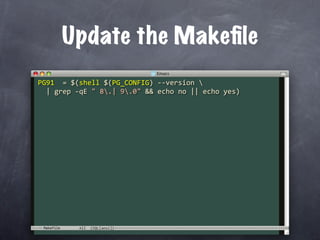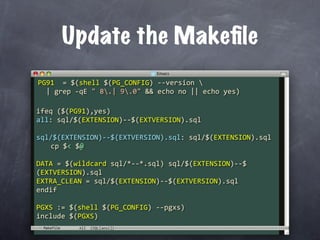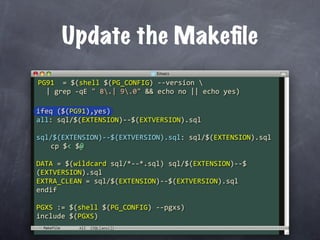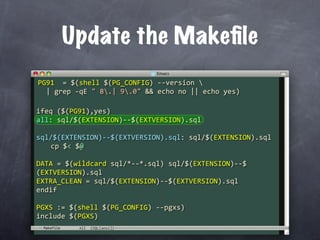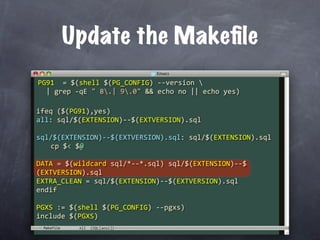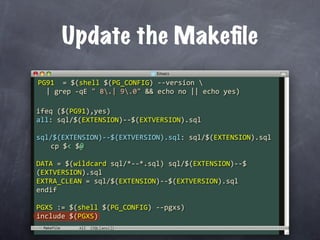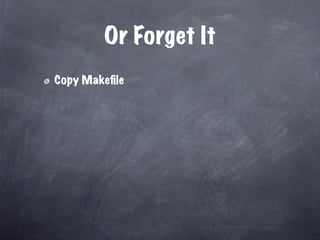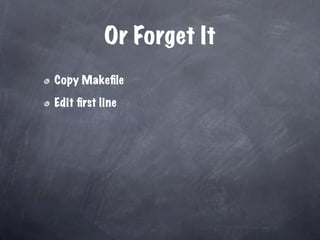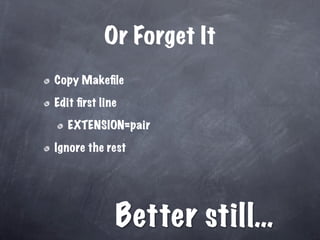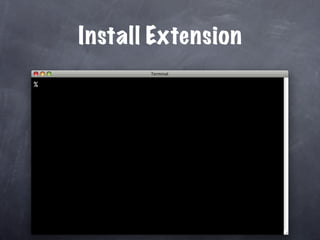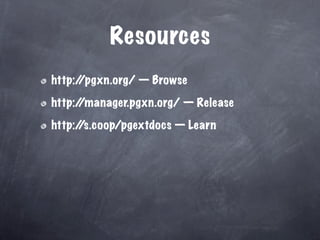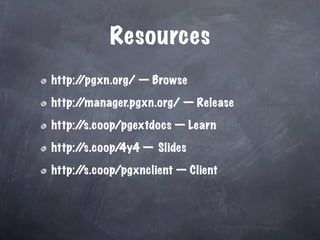Ad
Building and Distributing PostgreSQL Extensions Without Learning C
- 1. Building and Distributing PostgreSQL Extensions Without Learning C David E. Wheeler PostgreSQL Experts, Inc. PGXPUG PgDay 2011 Text: Attribution-Noncommercial-Share Alike 3.0 United States: http://creativecommons.org/licenses/by-nc-sa/3.0/us/ Images licensed independently and © Their respective owners.
- 3. There are quite a few PostgreSQL Extensions.
- 5. Core Extensions intagg pgcrypto intarray btree_gin hstore chkpass citext dblink cube earthdistance isn fuzzystrmatch
- 7. Common Extensions PostGIS PL/R temporal OracleFCE pgmemcache mysqlcompat PL/Proxy pg_randomness PL/Java pgTAP PL/Ruby
- 9. You can create extensions, too!
- 13. “Sure, but I get C sick.”
- 15. Fortunately…
- 17. There are many ways to extend PostgreSQL.
- 24. Functions CREATE FUNCTION truthy( text ) RETURNS BOOLEAN IMMUTABLE LANGUAGE SQL AS $$ SELECT $1 IS NOT NULL AND $1 NOT IN ('', '0') AND NOT $1 ~ '^[0.]+$'; $$; truth.sql Might be handy!
- 33. Domains CREATE OR REPLACE FUNCTION is_timezone( tz CITEXT ) RETURNS BOOLEAN LANGUAGE plpgsql STABLE AS $$ BEGIN PERFORM NOW() AT TIME ZONE tz; RETURN TRUE; EXCEPTION WHEN invalid_parameter_value THEN RETURN FALSE; END; $$; I use this CREATE DOMAIN timezone AS CITEXT CHECK ( is_timezone( VALUE ) ); timezone.sql
- 34. Types pair.sql
- 44. Operators CREATE OPERATOR @ ( RIGHTARG = text, PROCEDURE = truthy ); SELECT @'foo'; ‐‐ true SELECT @''; ‐‐ false truthy.sql
- 45. Operators CREATE OPERATOR @ ( RIGHTARG = text, PROCEDURE = truthy ); SELECT @'foo'; ‐‐ true SELECT @''; ‐‐ false truthy.sql I could use this!
- 47. PostgreSQL is not merely a database…
- 53. And combine them when building apps.
- 56. Let’s create an extension and distribute it.
- 57. The Steps
- 58. The Steps Stub source, test, and doc files
- 59. The Steps Stub source, test, and doc files Create the Makefile
- 60. The Steps Stub source, test, and doc files Create the Makefile Write the tests
- 61. The Steps Stub source, test, and doc files Create the Makefile Write the tests Write the code
- 62. The Steps Stub source, test, and doc files Create the Makefile Write the tests Write the code Write the docs
- 63. The Steps Stub source, test, and doc files Create the Makefile Write the tests Write the code Write the docs Create the metadata file
- 64. The Steps Stub source, test, and doc files Create the Makefile Write the tests Write the code Write the docs Create the metadata file Package it up
- 65. The Steps Stub source, test, and doc files Create the Makefile Write the tests Write the code Write the docs Create the metadata file Package it up Release
- 70. Stub the Source SET client_min_messages = warning; ‐‐ Create the type here. sql/pair.sql sql/pair.sql
- 72. Stub the Tests BEGIN; set ECHO 0 set QUIET 1 i sql/pair.sql set QUIET 0 ROLLBACK; test/sql/base.sql
- 73. Stub the Tests BEGIN; set ECHO 0 set QUIET 1 i sql/pair.sql set QUIET 0 ROLLBACK; test/sql/base.sql
- 74. Stub the Tests BEGIN; set ECHO 0 set QUIET 1 i sql/pair.sql set QUIET 0 ROLLBACK; test/sql/base.sql test/sql/base.sql
- 77. Stub the Docs pair 0.1.0 doc/pair.txt ========== Synopsis ‐‐‐‐‐‐‐‐ ‐‐ Example code here. Description ‐‐‐‐‐‐‐‐‐‐‐ This library blah blah blah... Usage ‐‐‐‐‐ Here's how to use this library. Author ‐‐‐‐‐‐ [David E. Wheeler](http://justatheory.com/) Copyright ‐‐‐‐‐‐‐‐‐ Copyright (c) 2010 David E. Wheeler. test/sql/base.sql
- 87. Create the Makefile inputdir DATA = $(wildcard sql/*.sql) DOCS = $(wildcard doc/*.*) MODULES = $(patsubst %.c,%,$(wildcard src/*.c)) TESTS = $(wildcard test/sql/*.sql) REGRESS = $(patsubst test/sql/%.sql,%,$(TESTS)) REGRESS_OPTS = ‐‐inputdir=test Makefile
- 92. Give it a Try %
- 93. Give it a Try make % make: Nothing to be done for `all'. %
- 94. Give it a Try make % make: Nothing to be done for `all'. make installcheck % pg_regress ‐‐psqldir=/pgsql/bin ‐‐inputdir=test base === dropping database "regression" === DROP DATABASE === creating database "regression" === CREATE DATABASE ALTER DATABASE === running regression test queries === test base ... diff: test/expected/base.out: No such file or directory diff command failed with status 512: diff "test/expected/base.out" "results/base.out" > "results/base.out.diff" make: *** [installcheck] Error 2 %
- 95. Give it a Try make % make: Nothing to be done for `all'. make installcheck % pg_regress ‐‐psqldir=/pgsql/bin ‐‐inputdir=test base === dropping database "regression" === DROP DATABASE === creating database "regression" === CREATE DATABASE ALTER DATABASE === running regression test queries === test base ... diff: test/expected/base.out: No such file or directory diff command failed with status 512: diff "test/expected/base.out" "results/base.out" > "results/base.out.diff" make: *** [installcheck] Error 2 %
- 96. Give it a Try make % make: Nothing to be done for `all'. make installcheck % pg_regress ‐‐psqldir=/pgsql/bin ‐‐inputdir=test base === dropping database "regression" === DROP DATABASE === creating database "regression" === We’ll come CREATE DATABASE ALTER DATABASE back to that. === running regression test queries === test base ... diff: test/expected/base.out: No such file or directory diff command failed with status 512: diff "test/expected/base.out" "results/base.out" > "results/base.out.diff" make: *** [installcheck] Error 2 %
- 97. Write Some Tests i sql/pair.sql set QUIET 0 ROLLBACK; test/sql/base.sql
- 102. Run Them %
- 104. Run Them % psql ‐d try ‐Xf test/sql/base.sql BEGIN psql:test/sql/base.sql:15: ERROR: function pair(unknown, unknown) does not exist LINE 1: SELECT pair('foo', 'bar') ^ ROLLBACK % Guess we should write it.
- 112. %
- 119. %
- 121. (foo,1) (foo,bar) % (foo,woah) (ick,foo) (7 rows) psql:test/sql/base.sql:25: ERROR: operator unknown ~> unknown LINE 1: SELECT 'foo' ~> 'bar' AS arrowop ^ Guess we HINT: No operator matches the given name an should write it. type(s). You might need to add explicit type ROLLBACK %
- 123. CREATE OR REPLACE FUNCTION pair(text, text) RETURNS pair LANGUAGE SQL AS 'SELECT ROW($1, $2)::pair;'; CREATE OPERATOR ~> ( LEFTARG = text, RIGHTARG = anyelement, PROCEDURE = pair ); CREATE OPERATOR ~> ( LEFTARG = anyelement, RIGHTARG = text, PROCEDURE = pair ); CREATE OPERATOR ~> ( LEFTARG = anyelement, RIGHTARG = anyelement, PROCEDURE = pair ); CREATE OPERATOR ~> ( LEFTARG = text, RIGHTARG = text, PROCEDURE = pair ); sql/pair.sql
- 124. CREATE OR REPLACE FUNCTION pair(text, text) RETURNS pair LANGUAGE SQL AS 'SELECT ROW($1, $2)::pair;'; CREATE OPERATOR ~> ( LEFTARG = text, RIGHTARG = anyelement, PROCEDURE = pair ); CREATE OPERATOR ~> ( LEFTARG = anyelement, RIGHTARG = text, PROCEDURE = pair ); CREATE OPERATOR ~> ( LEFTARG = anyelement, RIGHTARG = anyelement, PROCEDURE = pair ); CREATE OPERATOR ~> ( LEFTARG = text, RIGHTARG = text, PROCEDURE = pair ); sql/pair.sql
- 125. CREATE OR REPLACE FUNCTION pair(text, text) RETURNS pair LANGUAGE SQL AS 'SELECT ROW($1, $2)::pair;'; CREATE OPERATOR ~> ( LEFTARG = text, RIGHTARG = anyelement, PROCEDURE = pair ); CREATE OPERATOR ~> ( LEFTARG = anyelement, RIGHTARG = text, PROCEDURE = pair ); CREATE OPERATOR ~> ( LEFTARG = anyelement, RIGHTARG = anyelement, PROCEDURE = pair ); CREATE OPERATOR ~> ( LEFTARG = text, RIGHTARG = text, PROCEDURE = pair ); sql/pair.sql
- 126. CREATE OR REPLACE FUNCTION pair(text, text) RETURNS pair LANGUAGE SQL AS 'SELECT ROW($1, $2)::pair;'; CREATE OPERATOR ~> ( LEFTARG = text, RIGHTARG = anyelement, PROCEDURE = pair ); CREATE OPERATOR ~> ( LEFTARG = anyelement, RIGHTARG = text, PROCEDURE = pair ); CREATE OPERATOR ~> ( LEFTARG = anyelement, RIGHTARG = anyelement, PROCEDURE = pair ); CREATE OPERATOR ~> ( LEFTARG = text, RIGHTARG = text, PROCEDURE = pair ); sql/pair.sql
- 127. CREATE OR REPLACE FUNCTION pair(text, text) RETURNS pair LANGUAGE SQL AS 'SELECT ROW($1, $2)::pair;'; CREATE OPERATOR ~> ( LEFTARG = text, RIGHTARG = anyelement, PROCEDURE = pair ); CREATE OPERATOR ~> ( LEFTARG = anyelement, RIGHTARG = text, PROCEDURE = pair ); CREATE OPERATOR ~> ( LEFTARG = anyelement, RIGHTARG = anyelement, PROCEDURE = pair ); CREATE OPERATOR ~> ( LEFTARG = text, RIGHTARG = text, PROCEDURE = pair ); sql/pair.sql
- 128. %
- 130. (foo,bar) (foo,woah) % (ick,foo) (7 rows) arrowop ‐‐‐‐‐‐‐‐‐‐‐‐ (1,12) (12.3,foo) (HEY,bar) (foo,1) (foo,bar) (foo,woah) (ick,foo) (7 rows) Yay! ROLLBACK
- 131. One More Time! UNION SELECT 12.3 ~> 'foo'::text UNION SELECT 1 ~> 12 ORDER BY arrowop; ROLLBACK; test/sql/base.sql
- 138. %
- 139. % psql ‐d try ‐Xf test/sql/base.sql BEGIN pair ‐‐‐‐‐‐‐‐‐‐‐‐ (1,12) (12.3,foo) (HEY,bar) (foo,1) (foo,bar) (foo,woah) (ick,foo) (7 rows) arrowop ‐‐‐‐‐‐‐‐‐‐‐‐ (1,12) (12.3,foo) (HEY,bar) (foo,1) (foo,bar) (foo,woah) (ick,foo) (7 rows) CREATE TABLE INSERT 0 2 k | v ‐‐‐‐‐+‐‐‐‐‐ 1 | 2 foo | bar (2 rows) k | v ‐‐‐‐‐+‐‐‐‐‐ foo | bar We’re golden! (1 row) k | v ‐‐‐‐‐+‐‐‐‐‐ foo | bar (1 row) ROLLBACK %
- 140. Remember This? %
- 142. Let’s Fix That %
- 147. Where are We? Stub source, test, and doc files Create the Makefile Write the tests Write the code Write the docs Create the metadata file Package it up Release
- 148. Where are We? ✔ Stub source, test, and doc files Create the Makefile Write the tests Write the code Write the docs Create the metadata file Package it up Release
- 149. Where are We? ✔ Stub source, test, and doc files ✔ Create the Makefile Write the tests Write the code Write the docs Create the metadata file Package it up Release
- 150. Where are We? ✔ Stub source, test, and doc files ✔ Create the Makefile ✔ Write the tests Write the code Write the docs Create the metadata file Package it up Release
- 151. Where are We? ✔ Stub source, test, and doc files ✔ Create the Makefile ✔ Write the tests ✔ Write the code Write the docs Create the metadata file Package it up Release
- 156. META.json META.json
- 161. META.json { semver.org "name": "pair", "abstract": "A key/value pair data type", "version": "0.1.0", "maintainer": "Tom Lane <[email protected]>", "license": "postgresql", "provides": { "pair": { "file": "pair.sql", "version": "0.1.0" } }, "meta‐spec": { "version": "1.0.0", "url": "http://pgxn.org/meta/spec.txt" } } META.json
- 167. Package it Up! %
- 169. Package it Up! % git archive ‐‐format zip ‐‐prefix=pair‐0.1.0/ ‐‐output ~/Desktop/pair‐0.1.0.zip master % Easy, eh?
- 170. Where are We? ✔ Stub source, test, and doc files ✔ Create the Makefile ✔ Write the tests ✔ Write the code Write the docs Create the metadata file Package it up Release
- 171. Where are We? ✔ Stub source, test, and doc files ✔ Create the Makefile ✔ Write the tests ✔ Write the code ✔ Write the docs Create the metadata file Package it up Release
- 172. Where are We? ✔ Stub source, test, and doc files ✔ Create the Makefile ✔ Write the tests ✔ Write the code ✔ Write the docs ✔ Create the metadata file Package it up Release
- 173. Where are We? ✔ Stub source, test, and doc files ✔ Create the Makefile ✔ Write the tests ✔ Write the code ✔ Write the docs ✔ Create the metadata file ✔ Package it up Release
- 177. Tom Lane [email protected] http://postgresql.org/~tgl/ tomlane @tomlane I’ve got some killer extensions in development that I think will be useful to everyone, including: * pair: an ordered pair data type * PL/Brainfuck: just what it sounds like
- 178. Tom Lane [email protected] http://postgresql.org/~tgl/ tomlane @tomlane I’ve got some killer extensions in development that I think will be useful to everyone, including: * pair: an ordered pair data type * PL/Brainfuck: just what it sounds like
- 179. tomlane
- 183. omg WTF ROTFL lolz omg WTF ROTFL lolz
- 184. omg WTF ROTFL lolz omg WTF ROTFL lolz
- 195. tomlane
- 196. tomlane
- 197. META.json
- 203. Where are We? ✔ Stub source, test, and doc files ✔ Create the Makefile ✔ Write the tests ✔ Write the code ✔ Write the docs ✔ Create the metadata file ✔ Package it up Release
- 204. Where are We? ✔ Stub source, test, and doc files ✔ Create the Makefile ✔ Write the tests ✔ Write the code ✔ Write the docs ✔ Create the metadata file ✔ Package it up ✔ Release
- 205. Why PGXN?
- 206. Why PGXN? World-wide network of mirrors
- 207. Why PGXN? World-wide network of mirrors Fully indexed extensions
- 208. Why PGXN? World-wide network of mirrors Fully indexed extensions RESTful metadata distribution
- 209. Why PGXN? World-wide network of mirrors Fully indexed extensions RESTful metadata distribution Search and documentation site
- 210. Why PGXN? World-wide network of mirrors Fully indexed extensions RESTful metadata distribution Search and documentation site Comprehensive REST API
- 211. Why PGXN? World-wide network of mirrors Fully indexed extensions RESTful metadata distribution Search and documentation site Comprehensive REST API Command-line client
- 213. pair
- 214. pair
- 218. PGXN Client %
- 224. Coming in 9.1
- 225. Coming in 9.1 9.1 adding extension support
- 226. Coming in 9.1 9.1 adding extension support CREATE EXTENSION pair WITH SCHEMA utils;
- 227. Coming in 9.1 9.1 adding extension support CREATE EXTENSION pair WITH SCHEMA utils; Encapsulates dump/restore
- 228. Coming in 9.1 9.1 adding extension support CREATE EXTENSION pair WITH SCHEMA utils; Encapsulates dump/restore Whatever is defined in the SQL script
- 229. Coming in 9.1 9.1 adding extension support CREATE EXTENSION pair WITH SCHEMA utils; Encapsulates dump/restore Whatever is defined in the SQL script Supporting it is easy
- 231. 9.1 Extension Packaging Control file
- 232. 9.1 Extension Packaging Control file Migration from unpackaged
- 233. 9.1 Extension Packaging Control file Migration from unpackaged pair--unpackaged--0.1.0.sql
- 234. 9.1 Extension Packaging Control file Migration from unpackaged pair--unpackaged--0.1.0.sql Properly-named SQL script
- 235. 9.1 Extension Packaging Control file Migration from unpackaged pair--unpackaged--0.1.0.sql Properly-named SQL script pair--0.1.0.sql
- 236. Create the control file pair.control
- 237. Create the control file # pair extension comment = 'A key/value pair data type' default_version = '0.1.0' module_pathname = '$libdir/pair' relocatable = true superuser = false pair.control
- 238. Create the control file # pair extension comment = 'A key/value pair data type' default_version = '0.1.0' module_pathname = '$libdir/pair' relocatable = true superuser = false pair.control
- 239. Create the control file Optional # pair extension comment = 'A key/value pair data type' default_version = '0.1.0' module_pathname = '$libdir/pair' relocatable = true superuser = false pair.control
- 240. Create the control file # pair extension comment = 'A key/value pair data type' default_version = '0.1.0' module_pathname = '$libdir/pair' relocatable = true superuser = false pair.control
- 241. Create the control file # pair extension comment = 'A key/value pair data type' default_version = '0.1.0' module_pathname = '$libdir/pair' relocatable = true superuser = false pair.control
- 242. Create the control file # pair extension For C comment = 'A key/value pair data type' default_version = '0.1.0' code module_pathname = '$libdir/pair' relocatable = true superuser = false pair.control
- 243. Create the control file # pair extension comment = 'A key/value pair data type' default_version = '0.1.0' module_pathname = '$libdir/pair' relocatable = true superuser = false pair.control
- 244. Create the control file # pair extension Can move comment = 'A key/value pair data type' schemas default_version = '0.1.0' module_pathname = '$libdir/pair' relocatable = true superuser = false pair.control
- 245. Create the control file # pair extension comment = 'A key/value pair data type' default_version = '0.1.0' module_pathname = '$libdir/pair' relocatable = true superuser = false pair.control
- 246. Create the control file # pair extension comment = 'A key/value pair data type' default_version = '0.1.0' module_pathname = '$libdir/pair' relocatable = true Not required superuser = false to install pair.control
- 247. Create the control file # pair extension comment = 'A key/value pair data type' default_version = '0.1.0' module_pathname = '$libdir/pair' relocatable = true superuser = false pair.control pair.control
- 248. Migration from Unpackaged sql/pair‐‐unpac…
- 249. Migration from Unpackaged ALTER EXTENSION pair ADD TYPE pair; ALTER EXTENSION pair ADD FUNCTION pair(anyelement, text); ALTER EXTENSION pair ADD FUNCTION pair(text, anyelement); ALTER EXTENSION pair ADD FUNCTION pair(anyelement, anyelement); ALTER EXTENSION pair ADD FUNCTION pair(text, text); ALTER EXTENSION pair ADD OPERATOR ~>(text, anyelement); ALTER EXTENSION pair ADD OPERATOR ~>(anyelement, text); ALTER EXTENSION pair ADD OPERATOR ~>(anyelement, anyelement); ALTER EXTENSION pair ADD OPERATOR ~>(text, text); sql/pair‐‐unpac…
- 250. Migration from Unpackaged ALTER EXTENSION pair ADD TYPE pair; ALTER EXTENSION pair ADD FUNCTION pair(anyelement, text); ALTER EXTENSION pair ADD FUNCTION pair(text, anyelement); ALTER EXTENSION pair ADD FUNCTION pair(anyelement, anyelement); ALTER EXTENSION pair ADD FUNCTION pair(text, text); ALTER EXTENSION pair ADD OPERATOR ~>(text, anyelement); ALTER EXTENSION pair ADD OPERATOR ~>(anyelement, text); ALTER EXTENSION pair ADD OPERATOR ~>(anyelement, anyelement); ALTER EXTENSION pair ADD OPERATOR ~>(text, text); sql/pair--unpackaged--0.1.0.sql sql/pair‐‐unpac…
- 255. Update the Makefile Extract from EXTENSION = pair EXTVERSION = $(shell grep default_version control file $(EXTENSION).control | sed ‐e "s/default_version[ ]*=[ ]*'([^']*)'/1/") DATA = $(filter‐out $(wildcard sql/*‐‐*.sql),$ (wildcard sql/*.sql)) DOCS = $(wildcard doc/*.*) TESTS = $(wildcard test/sql/*.sql) REGRESS = $(patsubst test/sql/%.sql,%,$(TESTS)) REGRESS_OPTS = ‐‐inputdir=test MODULES = $(patsubst %.c,%,$(wildcard src/*.c)) PG_CONFIG = pg_config PG91 = $(shell $(PG_CONFIG) ‐‐version | grep ‐qE " 8.| 9.0" && echo no || echo yes) Makefile
- 258. Update the Makefile PG91 = $(shell $(PG_CONFIG) ‐‐version | grep ‐qE " 8.| 9.0" && echo no || echo yes) Makefile
- 259. Update the Makefile PG91 = $(shell $(PG_CONFIG) ‐‐version | grep ‐qE " 8.| 9.0" && echo no || echo yes) ifeq ($(PG91),yes) all: sql/$(EXTENSION)‐‐$(EXTVERSION).sql sql/$(EXTENSION)‐‐$(EXTVERSION).sql: sql/$(EXTENSION).sql cp $< $@ DATA = $(wildcard sql/*‐‐*.sql) sql/$(EXTENSION)‐‐$ (EXTVERSION).sql EXTRA_CLEAN = sql/$(EXTENSION)‐‐$(EXTVERSION).sql endif PGXS := $(shell $(PG_CONFIG) ‐‐pgxs) include $(PGXS) Makefile
- 260. Update the Makefile PG91 = $(shell $(PG_CONFIG) ‐‐version | grep ‐qE " 8.| 9.0" && echo no || echo yes) ifeq ($(PG91),yes) all: sql/$(EXTENSION)‐‐$(EXTVERSION).sql sql/$(EXTENSION)‐‐$(EXTVERSION).sql: sql/$(EXTENSION).sql cp $< $@ DATA = $(wildcard sql/*‐‐*.sql) sql/$(EXTENSION)‐‐$ (EXTVERSION).sql EXTRA_CLEAN = sql/$(EXTENSION)‐‐$(EXTVERSION).sql endif PGXS := $(shell $(PG_CONFIG) ‐‐pgxs) include $(PGXS) Makefile
- 261. Update the Makefile PG91 = $(shell $(PG_CONFIG) ‐‐version | grep ‐qE " 8.| 9.0" && echo no || echo yes) ifeq ($(PG91),yes) all: sql/$(EXTENSION)‐‐$(EXTVERSION).sql sql/$(EXTENSION)‐‐$(EXTVERSION).sql: sql/$(EXTENSION).sql cp $< $@ DATA = $(wildcard sql/*‐‐*.sql) sql/$(EXTENSION)‐‐$ (EXTVERSION).sql EXTRA_CLEAN = sql/$(EXTENSION)‐‐$(EXTVERSION).sql endif PGXS := $(shell $(PG_CONFIG) ‐‐pgxs) include $(PGXS) Makefile
- 262. Update the Makefile PG91 = $(shell $(PG_CONFIG) ‐‐version | grep ‐qE " 8.| 9.0" && echo no || echo yes) ifeq ($(PG91),yes) all: sql/$(EXTENSION)‐‐$(EXTVERSION).sql sql/$(EXTENSION)‐‐$(EXTVERSION).sql: sql/$(EXTENSION).sql cp $< $@ DATA = $(wildcard sql/*‐‐*.sql) sql/$(EXTENSION)‐‐$ (EXTVERSION).sql EXTRA_CLEAN = sql/$(EXTENSION)‐‐$(EXTVERSION).sql endif PGXS := $(shell $(PG_CONFIG) ‐‐pgxs) include $(PGXS) Makefile
- 263. Update the Makefile PG91 = $(shell $(PG_CONFIG) ‐‐version | grep ‐qE " 8.| 9.0" && echo no || echo yes) ifeq ($(PG91),yes) all: sql/$(EXTENSION)‐‐$(EXTVERSION).sql sql/$(EXTENSION)‐‐$(EXTVERSION).sql: sql/$(EXTENSION).sql cp $< $@ DATA = $(wildcard sql/*‐‐*.sql) sql/$(EXTENSION)‐‐$ (EXTVERSION).sql EXTRA_CLEAN = sql/$(EXTENSION)‐‐$(EXTVERSION).sql endif PGXS := $(shell $(PG_CONFIG) ‐‐pgxs) include $(PGXS) Makefile
- 264. Update the Makefile PG91 = $(shell $(PG_CONFIG) ‐‐version | grep ‐qE " 8.| 9.0" && echo no || echo yes) ifeq ($(PG91),yes) all: sql/$(EXTENSION)‐‐$(EXTVERSION).sql sql/$(EXTENSION)‐‐$(EXTVERSION).sql: sql/$(EXTENSION).sql cp $< $@ DATA = $(wildcard sql/*‐‐*.sql) sql/$(EXTENSION)‐‐$ (EXTVERSION).sql EXTRA_CLEAN = sql/$(EXTENSION)‐‐$(EXTVERSION).sql endif PGXS := $(shell $(PG_CONFIG) ‐‐pgxs) include $(PGXS) Makefile
- 265. Update the Makefile PG91 = $(shell $(PG_CONFIG) ‐‐version | grep ‐qE " 8.| 9.0" && echo no || echo yes) ifeq ($(PG91),yes) all: sql/$(EXTENSION)‐‐$(EXTVERSION).sql sql/$(EXTENSION)‐‐$(EXTVERSION).sql: sql/$(EXTENSION).sql cp $< $@ DATA = $(wildcard sql/*‐‐*.sql) sql/$(EXTENSION)‐‐$ (EXTVERSION).sql EXTRA_CLEAN = sql/$(EXTENSION)‐‐$(EXTVERSION).sql endif PGXS := $(shell $(PG_CONFIG) ‐‐pgxs) include $(PGXS) Makefile
- 266. Update the Makefile PG91 = $(shell $(PG_CONFIG) ‐‐version | grep ‐qE " 8.| 9.0" && echo no || echo yes) ifeq ($(PG91),yes) all: sql/$(EXTENSION)‐‐$(EXTVERSION).sql sql/$(EXTENSION)‐‐$(EXTVERSION).sql: sql/$(EXTENSION).sql cp $< $@ DATA = $(wildcard sql/*‐‐*.sql) sql/$(EXTENSION)‐‐$ (EXTVERSION).sql EXTRA_CLEAN = sql/$(EXTENSION)‐‐$(EXTVERSION).sql endif PGXS := $(shell $(PG_CONFIG) ‐‐pgxs) include $(PGXS) Makefile
- 267. Or Forget It
- 268. Or Forget It Copy Makefile
- 269. Or Forget It Copy Makefile Edit first line
- 270. Or Forget It Copy Makefile Edit first line EXTENSION=pair
- 271. Or Forget It Copy Makefile Edit first line EXTENSION=pair Ignore the rest
- 272. Or Forget It Copy Makefile Edit first line EXTENSION=pair Ignore the rest Better still…
- 273. Skeleton in the Closet %
- 274. Skeleton in the Closet % sudo gem install pgxn_utils Installing ri documentation for pgxn_utils‐0.1.2... Installing RDoc documentation for pgxn_utils‐0.1.2... %
- 275. Skeleton in the Closet % sudo gem install pgxn_utils Installing ri documentation for pgxn_utils‐0.1.2... Installing RDoc documentation for pgxn_utils‐0.1.2... pgxn_utils skeleton semver % create semver create semver/semver.control create semver/META.json create semver/Makefile create semver/README.md create semver/doc/semver.md create semver/sql/semver.sql create semver/sql/uninstall_semver.sql create semver/test/expected/base.out create semver/test/sql/base.sql %
- 276. Thank you Dickson S. Guedes
- 277. Install Extension %
- 278. Install Extension pgxn load pair ‐d try % INFO: best version: pair 0.1.2 CREATE EXTENSION % Nice.
- 279. Resources
- 280. Resources http:/ /pgxn.org/ — Browse
- 281. Resources http:/ /pgxn.org/ — Browse http:/ /manager.pgxn.org/ — Release
- 282. Resources http:/ /pgxn.org/ — Browse http:/ /manager.pgxn.org/ — Release http:/ /s.coop/pgextdocs — Learn
- 283. Resources http:/ /pgxn.org/ — Browse http:/ /manager.pgxn.org/ — Release http:/ /s.coop/pgextdocs — Learn http:/ /s.coop/4y4 — Slides
- 284. Resources http:/ /pgxn.org/ — Browse http:/ /manager.pgxn.org/ — Release http:/ /s.coop/pgextdocs — Learn http:/ /s.coop/4y4 — Slides http:/ /s.coop/pgxnclient — Client
- 285. Resources http:/ /pgxn.org/ — Browse http:/ /manager.pgxn.org/ — Release http:/ /s.coop/pgextdocs — Learn http:/ /s.coop/4y4 — Slides http:/ /s.coop/pgxnclient — Client http:/ /s.coop/pgxnutils — Develop
- 286. Building and Distributing PostgreSQL Extensions Without Learning C David E. Wheeler PostgreSQL Experts, Inc. PGXPUG PgDay 2011 Text: Attribution-Noncommercial-Share Alike 3.0 United States: http://creativecommons.org/licenses/by-nc-sa/3.0/us/ Images licensed independently and © Their respective owners.
Editor's Notes
- #2: TODO:\n&#x2022; Add more privilege stuff?\n&#x2022; Add example of renaming `flips.timestamp`?\n
- #3: \n
- #4: \n
- #5: \n
- #6: \n
- #7: \n
- #8: \n
- #9: \n
- #10: \n
- #11: \n
- #12: \n
- #13: \n
- #14: \n
- #15: \n
- #16: \n
- #17: \n
- #18: \n
- #19: \n
- #20: \n
- #21: \n
- #22: \n
- #23: \n
- #24: \n
- #25: \n
- #26: \n
- #27: \n
- #28: \n
- #29: \n
- #30: \n
- #31: \n
- #32: \n
- #33: \n
- #34: \n
- #35: \n
- #36: \n
- #37: \n
- #38: \n
- #39: \n
- #40: \n
- #41: \n
- #42: \n
- #43: \n
- #44: \n
- #45: \n
- #46: \n
- #47: \n
- #48: \n
- #49: \n
- #50: \n
- #51: \n
- #52: \n
- #53: \n
- #54: \n
- #55: \n
- #56: \n
- #57: \n
- #58: \n
- #59: \n
- #60: \n
- #61: \n
- #62: \n
- #63: \n
- #64: \n
- #65: \n
- #66: \n
- #67: \n
- #68: \n
- #69: \n
- #70: \n
- #71: \n
- #72: \n
- #73: \n
- #74: \n
- #75: \n
- #76: \n
- #77: \n
- #78: \n
- #79: \n
- #80: \n
- #81: \n
- #82: \n
- #83: \n
- #84: \n
- #85: \n
- #86: \n
- #87: \n
- #88: \n
- #89: \n
- #90: \n
- #91: \n
- #92: \n
- #93: \n
- #94: \n
- #95: \n
- #96: \n
- #97: \n
- #98: \n
- #99: \n
- #100: \n
- #101: \n
- #102: \n
- #103: \n
- #104: \n
- #105: \n
- #106: \n
- #107: \n
- #108: \n
- #109: \n
- #110: \n
- #111: \n
- #112: \n
- #113: \n
- #114: \n
- #115: \n
- #116: \n
- #117: \n
- #118: \n
- #119: \n
- #120: \n
- #121: \n
- #122: \n
- #123: \n
- #124: \n
- #125: \n
- #126: \n
- #127: \n
- #128: \n
- #129: \n
- #130: \n
- #131: \n
- #132: \n
- #133: \n
- #134: \n
- #135: \n
- #136: \n
- #137: \n
- #138: \n
- #139: \n
- #140: \n
- #141: \n
- #142: \n
- #143: \n
- #144: \n
- #145: \n
- #146: \n
- #147: \n
- #148: \n
- #149: \n
- #150: \n
- #151: \n
- #152: \n
- #153: \n
- #154: \n
- #155: \n
- #156: \n
- #157: \n
- #158: \n
- #159: \n
- #160: \n
- #161: \n
- #162: \n
- #163: \n
- #164: \n
- #165: \n
- #166: \n
- #167: \n
- #168: \n
- #169: \n
- #170: \n
- #171: \n
- #172: \n
- #173: \n
- #174: \n
- #175: \n
- #176: \n
- #177: \n
- #178: \n
- #179: \n
- #180: \n
- #181: \n
- #182: \n
- #183: \n
- #184: \n
- #185: \n
- #186: \n
- #187: \n
- #188: \n
- #189: \n
- #190: \n
- #191: \n
- #192: \n
- #193: \n
- #194: \n
- #195: \n
- #196: \n
- #197: \n
- #198: \n
- #199: \n
- #200: \n
- #201: \n
- #202: \n
- #203: \n
- #204: \n
- #205: \n
- #206: \n
- #207: \n
- #208: \n
- #209: \n
- #210: \n
- #211: \n
- #212: \n
- #213: \n
- #214: \n
- #215: \n
- #216: \n
- #217: \n
- #218: \n
- #219: \n
- #220: \n
- #221: \n
- #222: \n
- #223: \n
- #224: \n
- #225: \n
- #226: \n
- #227: \n
- #228: \n
- #229: \n
- #230: \n
- #231: \n
- #232: \n
- #233: \n
- #234: \n
- #235: \n
- #236: \n
- #237: \n
- #238: \n
- #239: \n
- #240: \n
- #241: \n
- #242: \n
- #243: \n
- #244: \n
- #245: \n
- #246: \n
- #247: \n
- #248: \n
- #249: \n
- #250: \n
- #251: \n
- #252: \n
- #253: \n
- #254: \n
- #255: \n
- #256: \n
- #257: \n
- #258: \n
- #259: \n
- #260: \n
- #261: \n
- #262: \n
- #263: \n
- #264: \n
- #265: \n
- #266: \n
- #267: \n
- #268: \n
- #269: \n
- #270: \n
- #271: \n
- #272: \n
- #273: \n
- #274: \n
- #275: \n
- #276: \n
- #277: \n
- #278: \n
- #279: \n
- #280: \n
- #281: \n
- #282: \n
- #283: \n
- #284: \n
- #285: \n
- #286: \n
- #287: \n
- #288: \n
- #289: \n
- #290: \n
- #291: \n
- #292: \n
- #293: \n
- #294: \n
- #295: \n
- #296: \n
- #297: \n
- #298: \n
- #299: \n
- #300: \n
- #301: \n
- #302: \n
- #303: \n
- #304: \n
- #305: \n
- #306: \n
- #307: \n
- #308: \n
- #309: \n
- #310: \n
- #311: \n
- #312: \n
- #313: \n
- #314: \n
- #315: \n
- #316: \n
- #317: \n
- #318: \n
- #319: \n
- #320: \n
- #321: \n
- #322: \n
- #323: \n
- #324: \n
- #325: \n
- #326: \n
- #327: \n
- #328: \n
- #329: \n
- #330: \n
- #331: \n
- #332: \n
- #333: \n
- #334: \n

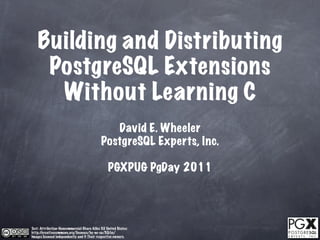



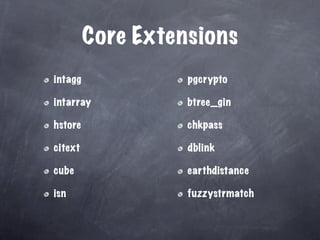













![Functions
CREATE
FUNCTION
truthy(
text
)
RETURNS
BOOLEAN
IMMUTABLE
LANGUAGE
SQL
AS
$$
SELECT
$1
IS
NOT
NULL
AND
$1
NOT
IN
('',
'0')
AND
NOT
$1
~
'^[0.]+$';
$$;
truth.sql](https://image.slidesharecdn.com/extendingpostgresql-110724134253-phpapp02/85/Building-and-Distributing-PostgreSQL-Extensions-Without-Learning-C-19-320.jpg)
![Functions
CREATE
FUNCTION
truthy(
text
)
RETURNS
BOOLEAN
IMMUTABLE
LANGUAGE
SQL
AS
$$
SELECT
$1
IS
NOT
NULL
AND
$1
NOT
IN
('',
'0')
AND
NOT
$1
~
'^[0.]+$';
$$;
truth.sql](https://image.slidesharecdn.com/extendingpostgresql-110724134253-phpapp02/85/Building-and-Distributing-PostgreSQL-Extensions-Without-Learning-C-20-320.jpg)
![Functions
CREATE
FUNCTION
truthy(
text
)
RETURNS
BOOLEAN
IMMUTABLE
LANGUAGE
SQL
AS
$$
SELECT
$1
IS
NOT
NULL
AND
$1
NOT
IN
('',
'0')
AND
NOT
$1
~
'^[0.]+$';
$$;
truth.sql](https://image.slidesharecdn.com/extendingpostgresql-110724134253-phpapp02/85/Building-and-Distributing-PostgreSQL-Extensions-Without-Learning-C-21-320.jpg)
![Functions
CREATE
FUNCTION
truthy(
text
)
RETURNS
BOOLEAN
IMMUTABLE
LANGUAGE
SQL
AS
$$
SELECT
$1
IS
NOT
NULL
AND
$1
NOT
IN
('',
'0')
AND
NOT
$1
~
'^[0.]+$';
$$;
truth.sql](https://image.slidesharecdn.com/extendingpostgresql-110724134253-phpapp02/85/Building-and-Distributing-PostgreSQL-Extensions-Without-Learning-C-22-320.jpg)
![Functions
CREATE
FUNCTION
truthy(
text
)
RETURNS
BOOLEAN
IMMUTABLE
LANGUAGE
SQL
AS
$$
SELECT
$1
IS
NOT
NULL
AND
$1
NOT
IN
('',
'0')
AND
NOT
$1
~
'^[0.]+$';
$$;
truth.sql](https://image.slidesharecdn.com/extendingpostgresql-110724134253-phpapp02/85/Building-and-Distributing-PostgreSQL-Extensions-Without-Learning-C-23-320.jpg)
![Functions
CREATE
FUNCTION
truthy(
text
)
RETURNS
BOOLEAN
IMMUTABLE
LANGUAGE
SQL
AS
$$
SELECT
$1
IS
NOT
NULL
AND
$1
NOT
IN
('',
'0')
AND
NOT
$1
~
'^[0.]+$';
$$;
truth.sql
Might be handy!](https://image.slidesharecdn.com/extendingpostgresql-110724134253-phpapp02/85/Building-and-Distributing-PostgreSQL-Extensions-Without-Learning-C-24-320.jpg)
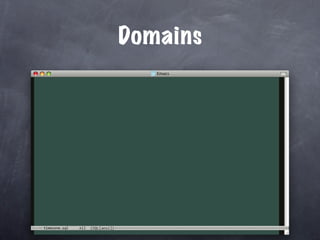
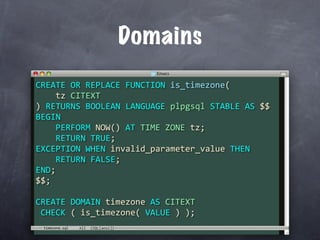
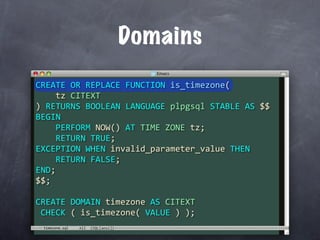
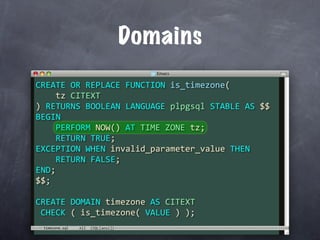



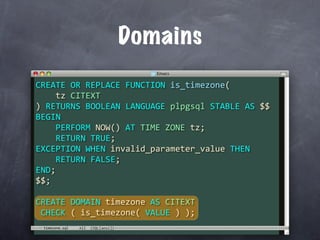

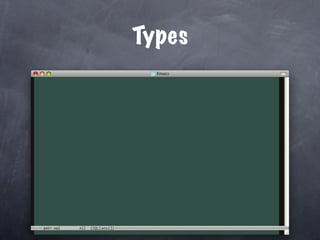
![Types
CREATE
TYPE
pair
AS
(
k
text,
v
text
);
CREATE
OR
REPLACE
FUNCTION
store(
params
variadic
pair[]
)
RETURNS
VOID
LANGUAGE
plpgsql
AS
$$
DECLARE
param
pair;
BEGIN
FOR
param
IN
SELECT
*
FROM
unnest(params)
LOOP
‐‐
...
END
LOOP;
END;
$$
pair.sql](https://image.slidesharecdn.com/extendingpostgresql-110724134253-phpapp02/85/Building-and-Distributing-PostgreSQL-Extensions-Without-Learning-C-35-320.jpg)
![Types
CREATE
TYPE
pair
AS
(
k
text,
v
text
);
CREATE
OR
REPLACE
FUNCTION
store(
params
variadic
pair[]
)
RETURNS
VOID
LANGUAGE
plpgsql
AS
$$
DECLARE
param
pair;
BEGIN
FOR
param
IN
SELECT
*
FROM
unnest(params)
LOOP
‐‐
...
END
LOOP;
END;
$$
pair.sql](https://image.slidesharecdn.com/extendingpostgresql-110724134253-phpapp02/85/Building-and-Distributing-PostgreSQL-Extensions-Without-Learning-C-36-320.jpg)
![Types
CREATE
TYPE
pair
AS
(
k
text,
v
text
);
CREATE
OR
REPLACE
FUNCTION
store(
params
variadic
pair[]
)
RETURNS
VOID
LANGUAGE
plpgsql
AS
$$
DECLARE
param
pair;
BEGIN
FOR
param
IN
SELECT
*
FROM
unnest(params)
LOOP
‐‐
...
END
LOOP;
END;
$$
pair.sql](https://image.slidesharecdn.com/extendingpostgresql-110724134253-phpapp02/85/Building-and-Distributing-PostgreSQL-Extensions-Without-Learning-C-37-320.jpg)
![Types
CREATE
TYPE
pair
AS
(
k
text,
v
text
);
CREATE
OR
REPLACE
FUNCTION
store(
params
variadic
pair[]
)
RETURNS
VOID
LANGUAGE
plpgsql
AS
$$
DECLARE
param
pair;
BEGIN
FOR
param
IN
SELECT
*
FROM
unnest(params)
LOOP
‐‐
...
END
LOOP;
END;
$$
pair.sql](https://image.slidesharecdn.com/extendingpostgresql-110724134253-phpapp02/85/Building-and-Distributing-PostgreSQL-Extensions-Without-Learning-C-38-320.jpg)
![Types
CREATE
TYPE
pair
AS
(
k
text,
v
text
);
CREATE
OR
REPLACE
FUNCTION
store(
params
variadic
pair[]
)
RETURNS
VOID
LANGUAGE
plpgsql
AS
$$
DECLARE
param
pair;
BEGIN
FOR
param
IN
SELECT
*
FROM
unnest(params)
LOOP
‐‐
...
END
LOOP;
END;
$$
pair.sql
Could be useful…](https://image.slidesharecdn.com/extendingpostgresql-110724134253-phpapp02/85/Building-and-Distributing-PostgreSQL-Extensions-Without-Learning-C-39-320.jpg)
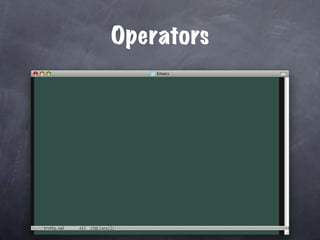
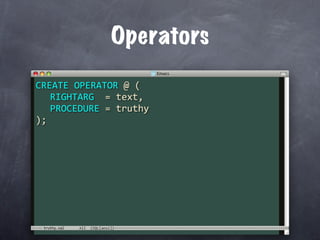

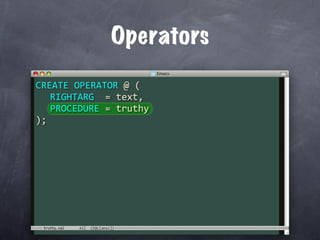
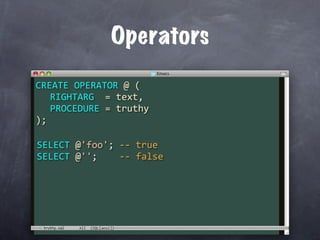




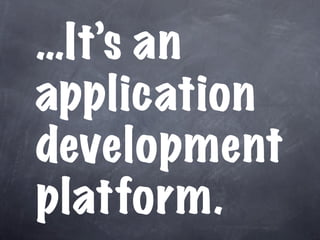










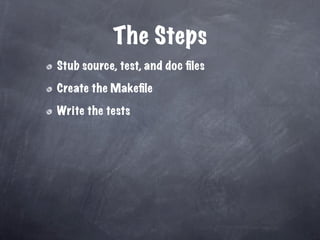
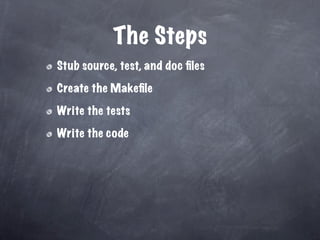


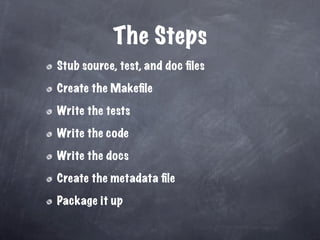

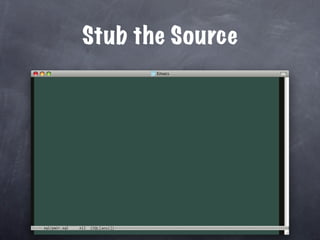

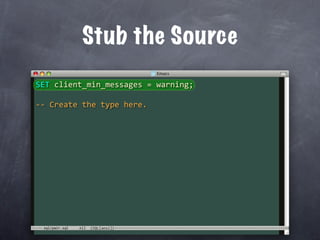


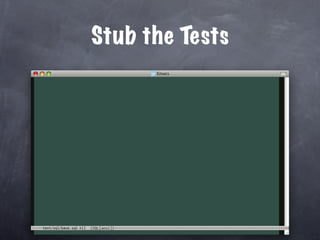

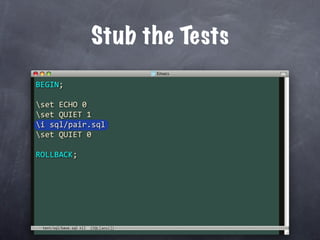



Copyright
‐‐‐‐‐‐‐‐‐
Copyright
(c)
2010
David
E.
Wheeler.
test/sql/base.sql](https://image.slidesharecdn.com/extendingpostgresql-110724134253-phpapp02/85/Building-and-Distributing-PostgreSQL-Extensions-Without-Learning-C-76-320.jpg)

Copyright
‐‐‐‐‐‐‐‐‐
Copyright
(c)
2010
David
E.
Wheeler.
test/sql/base.sql](https://image.slidesharecdn.com/extendingpostgresql-110724134253-phpapp02/85/Building-and-Distributing-PostgreSQL-Extensions-Without-Learning-C-77-320.jpg)




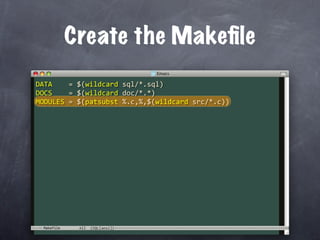
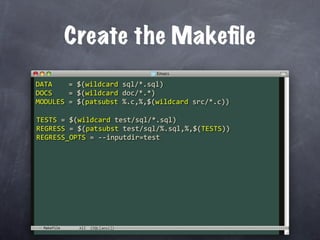


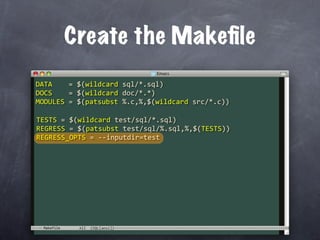
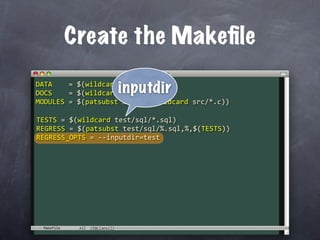
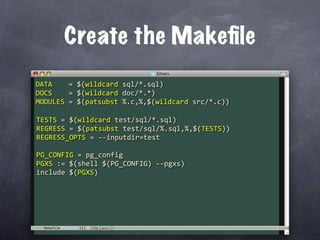

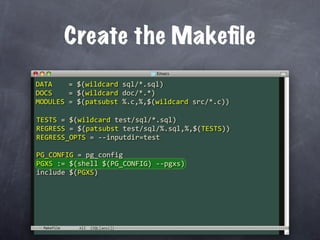
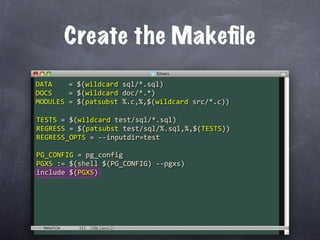


![Give it a Try
make
%
make:
Nothing
to
be
done
for
`all'.
make
installcheck
%
pg_regress
‐‐psqldir=/pgsql/bin
‐‐inputdir=test
base
===
dropping
database
"regression"
===
DROP
DATABASE
===
creating
database
"regression"
===
CREATE
DATABASE
ALTER
DATABASE
===
running
regression
test
queries
===
test
base
...
diff:
test/expected/base.out:
No
such
file
or
directory
diff
command
failed
with
status
512:
diff
"test/expected/base.out"
"results/base.out"
>
"results/base.out.diff"
make:
***
[installcheck]
Error
2
%](https://image.slidesharecdn.com/extendingpostgresql-110724134253-phpapp02/85/Building-and-Distributing-PostgreSQL-Extensions-Without-Learning-C-94-320.jpg)
![Give it a Try
make
%
make:
Nothing
to
be
done
for
`all'.
make
installcheck
%
pg_regress
‐‐psqldir=/pgsql/bin
‐‐inputdir=test
base
===
dropping
database
"regression"
===
DROP
DATABASE
===
creating
database
"regression"
===
CREATE
DATABASE
ALTER
DATABASE
===
running
regression
test
queries
===
test
base
...
diff:
test/expected/base.out:
No
such
file
or
directory
diff
command
failed
with
status
512:
diff
"test/expected/base.out"
"results/base.out"
>
"results/base.out.diff"
make:
***
[installcheck]
Error
2
%](https://image.slidesharecdn.com/extendingpostgresql-110724134253-phpapp02/85/Building-and-Distributing-PostgreSQL-Extensions-Without-Learning-C-95-320.jpg)
![Give it a Try
make
%
make:
Nothing
to
be
done
for
`all'.
make
installcheck
%
pg_regress
‐‐psqldir=/pgsql/bin
‐‐inputdir=test
base
===
dropping
database
"regression"
===
DROP
DATABASE
===
creating
database
"regression"
===
We’ll come
CREATE
DATABASE
ALTER
DATABASE
back to that.
===
running
regression
test
queries
===
test
base
...
diff:
test/expected/base.out:
No
such
file
or
directory
diff
command
failed
with
status
512:
diff
"test/expected/base.out"
"results/base.out"
>
"results/base.out.diff"
make:
***
[installcheck]
Error
2
%](https://image.slidesharecdn.com/extendingpostgresql-110724134253-phpapp02/85/Building-and-Distributing-PostgreSQL-Extensions-Without-Learning-C-96-320.jpg)
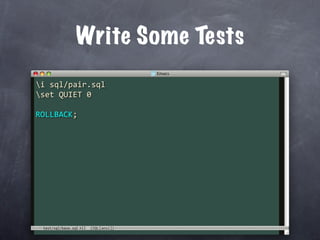


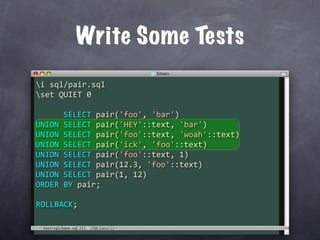

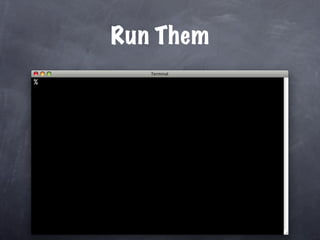




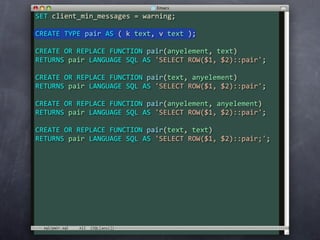




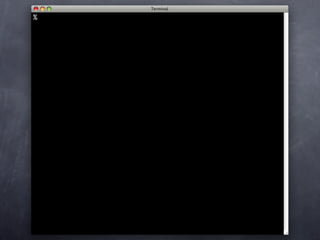
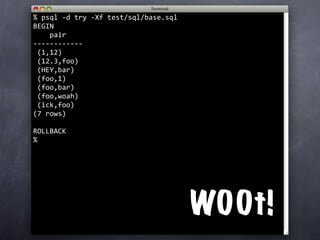
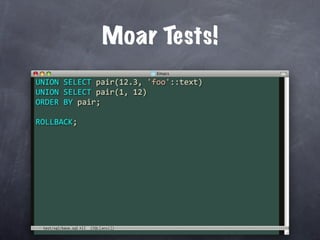

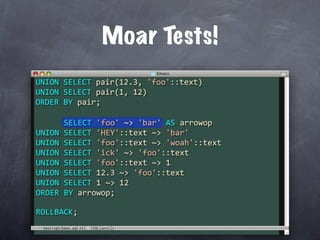


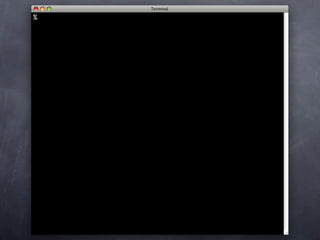
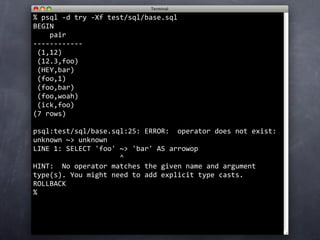



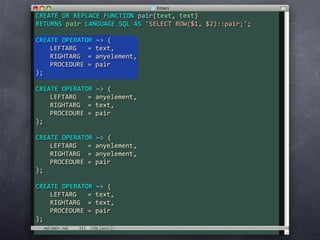
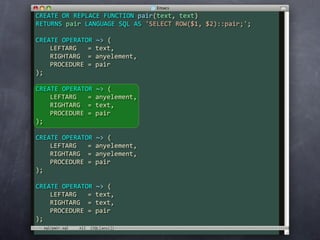

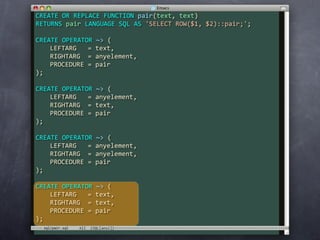
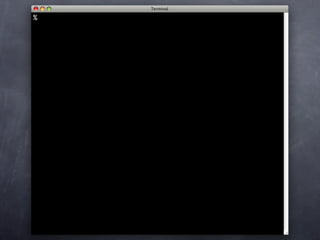


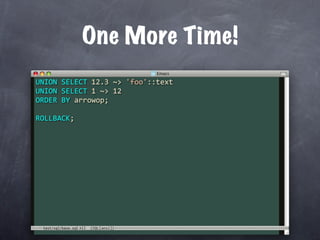

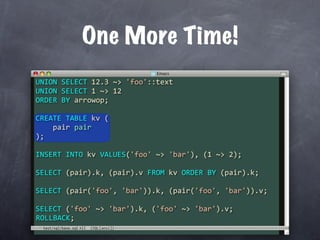

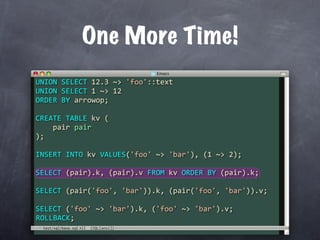

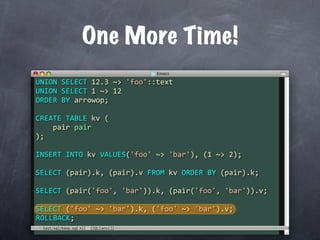



![Remember This?
%
make
installcheck
pg_regress
‐‐psqldir=/pgsql/bin
‐‐inputdir=test
base
===
dropping
database
"regression"
===
DROP
DATABASE
===
creating
database
"regression"
===
CREATE
DATABASE
ALTER
DATABASE
===
running
regression
test
queries
===
test
base
...
diff:
test/expected/base.out:
No
such
file
or
directory
diff
command
failed
with
status
512:
diff
"test/expected/base.out"
"results/base.out"
>
"results/base.out.diff"
make:
***
[installcheck]
Error
2
%](https://image.slidesharecdn.com/extendingpostgresql-110724134253-phpapp02/85/Building-and-Distributing-PostgreSQL-Extensions-Without-Learning-C-141-320.jpg)
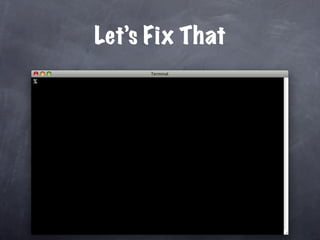
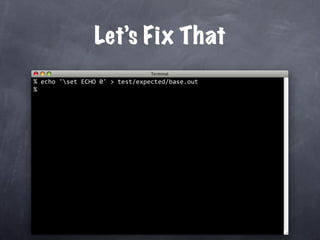
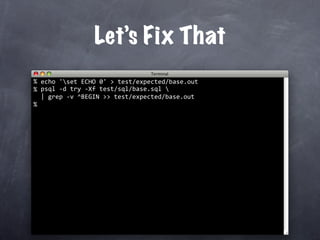


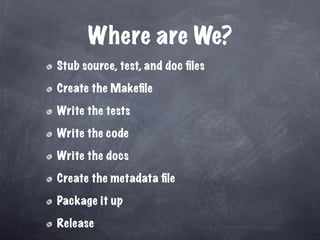

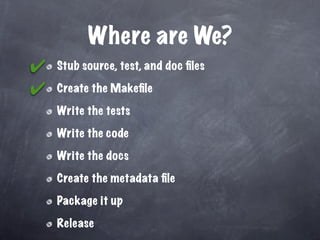



Copyright
‐‐‐‐‐‐‐‐‐
Copyright
(c)
2010
David
E.
Wheeler.
test/sql/base.sql](https://image.slidesharecdn.com/extendingpostgresql-110724134253-phpapp02/85/Building-and-Distributing-PostgreSQL-Extensions-Without-Learning-C-152-320.jpg)
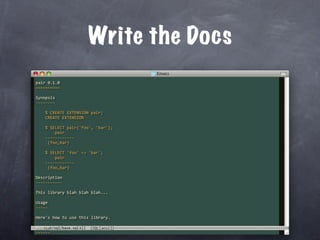

Copyright
‐‐‐‐‐‐‐‐‐
Copyright
(c)
2010
David
E.
Wheeler.
test/sql/base.sql](https://image.slidesharecdn.com/extendingpostgresql-110724134253-phpapp02/85/Building-and-Distributing-PostgreSQL-Extensions-Without-Learning-C-154-320.jpg)

Copyright
‐‐‐‐‐‐‐‐‐
Copyright
(c)
2010
David
E.
Wheeler.
test/sql/base.sql](https://image.slidesharecdn.com/extendingpostgresql-110724134253-phpapp02/85/Building-and-Distributing-PostgreSQL-Extensions-Without-Learning-C-155-320.jpg)
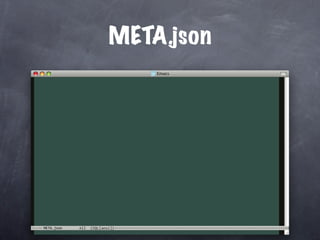
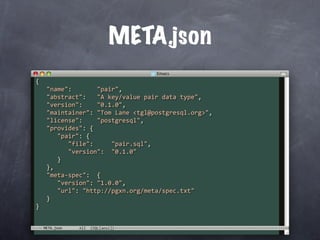
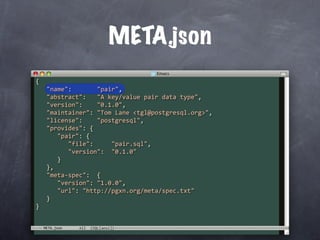





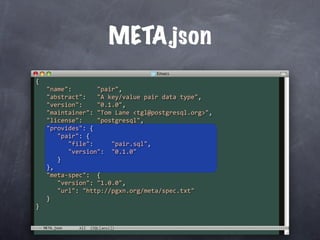


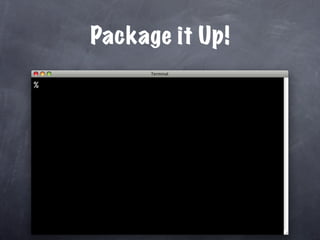



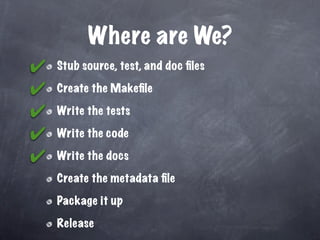
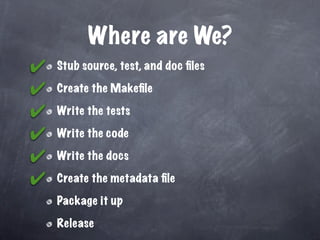
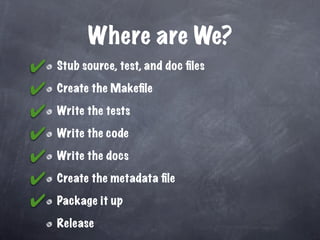
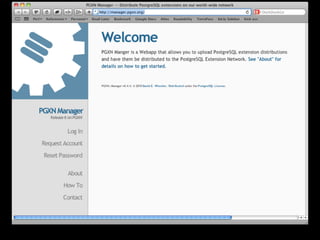
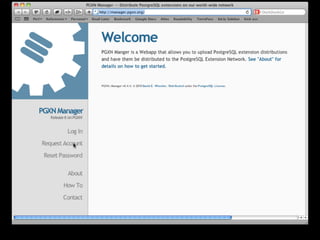
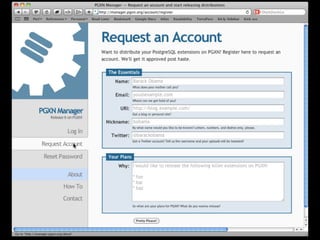
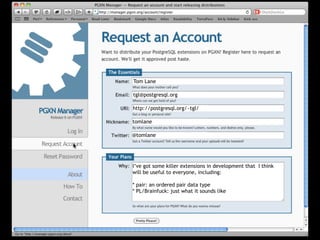





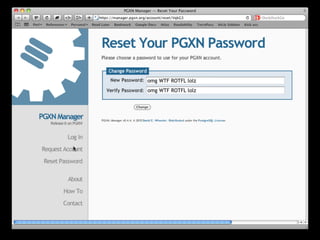




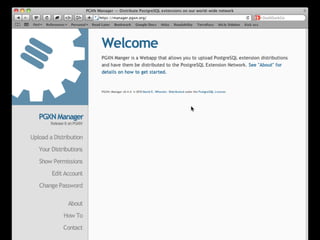
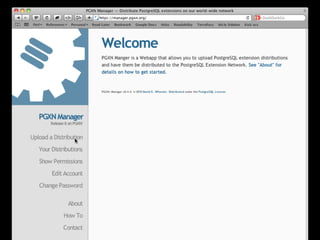

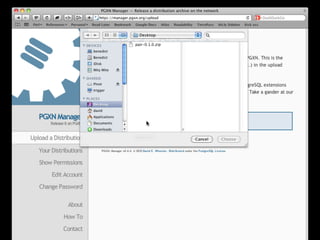
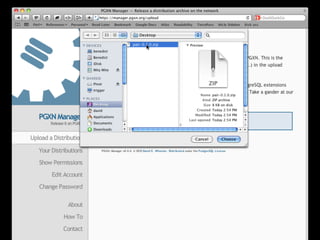

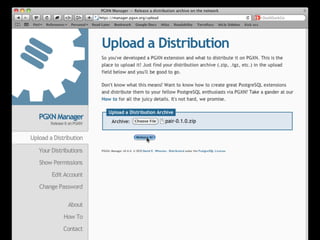

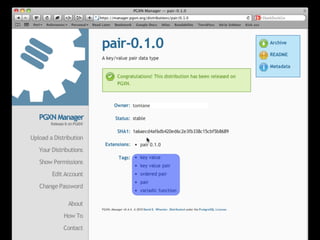

![{
"name":
"pair",
"abstract":
"A
key/value
pair
data
type",
"description":
"This
library
contains
a
single
PostgreSQL
extension,
a
key/value
"version":
"0.1.0",
"maintainer":
"Tom
Lane
<tgl@postgresql.org>",
"license":
"postgresql",
"provides":
{
"pair":
{
"file":
"sql/pair.sql",
"version":
"0.1.0"
}
},
"resources":
{
"bugtracker":
{
"web":
"http://github.com/tgl/kv‐pair/issues/"
},
"repository":
{
"url":
"git://github.com/tgl/kv‐pair.git",
"web":
"http://github.com/tgl/kv‐pair/",
"type":
"git"
}
},
"generated_by":
"Tom
Lane",
"meta‐spec":
{
"version":
"1.0.0",
"url":
"http://pgxn.org/meta/spec.txt"
},
"tags":
[
"variadic
function",
"ordered
pair",
"pair",
"key
value",
"key
value
pair"
]
}
META.json](https://image.slidesharecdn.com/extendingpostgresql-110724134253-phpapp02/85/Building-and-Distributing-PostgreSQL-Extensions-Without-Learning-C-198-320.jpg)
![{
"name":
"pair",
"abstract":
"A
key/value
pair
data
type",
"description":
"This
library
contains
a
single
PostgreSQL
extension,
a
key/value
"version":
"0.1.0",
"maintainer":
"Tom
Lane
<tgl@postgresql.org>",
"license":
"postgresql",
"provides":
{
"pair":
{
"file":
"sql/pair.sql",
"version":
"0.1.0"
}
},
"resources":
{
"bugtracker":
{
"web":
"http://github.com/tgl/kv‐pair/issues/"
},
"repository":
{
"url":
"git://github.com/tgl/kv‐pair.git",
"web":
"http://github.com/tgl/kv‐pair/",
"type":
"git"
}
},
"generated_by":
"Tom
Lane",
"meta‐spec":
{
"version":
"1.0.0",
"url":
"http://pgxn.org/meta/spec.txt"
},
"tags":
[
"variadic
function",
"ordered
pair",
"pair",
"key
value",
"key
value
pair"
]
}
META.json](https://image.slidesharecdn.com/extendingpostgresql-110724134253-phpapp02/85/Building-and-Distributing-PostgreSQL-Extensions-Without-Learning-C-199-320.jpg)
![{
"name":
"pair",
"abstract":
"A
key/value
pair
data
type",
"description":
"This
library
contains
a
single
PostgreSQL
extension,
a
key/value
"version":
"0.1.0",
"maintainer":
"Tom
Lane
<tgl@postgresql.org>",
"license":
"postgresql",
"provides":
{
"pair":
{
"file":
"sql/pair.sql",
"version":
"0.1.0"
}
},
"resources":
{
"bugtracker":
{
"web":
"http://github.com/tgl/kv‐pair/issues/"
},
"repository":
{
"url":
"git://github.com/tgl/kv‐pair.git",
"web":
"http://github.com/tgl/kv‐pair/",
"type":
"git"
}
},
"generated_by":
"Tom
Lane",
"meta‐spec":
{
"version":
"1.0.0",
"url":
"http://pgxn.org/meta/spec.txt"
},
"tags":
[
"variadic
function",
"ordered
pair",
"pair",
"key
value",
"key
value
pair"
]
}
META.json](https://image.slidesharecdn.com/extendingpostgresql-110724134253-phpapp02/85/Building-and-Distributing-PostgreSQL-Extensions-Without-Learning-C-200-320.jpg)
![{
"name":
"pair",
"abstract":
"A
key/value
pair
data
type",
"description":
"This
library
contains
a
single
PostgreSQL
extension,
a
key/value
"version":
"0.1.0",
"maintainer":
"Tom
Lane
<tgl@postgresql.org>",
"license":
"postgresql",
"provides":
{
"pair":
{
"file":
"sql/pair.sql",
"version":
"0.1.0"
}
},
"resources":
{
"bugtracker":
{
"web":
"http://github.com/tgl/kv‐pair/issues/"
},
"repository":
{
"url":
"git://github.com/tgl/kv‐pair.git",
"web":
"http://github.com/tgl/kv‐pair/",
"type":
"git"
}
},
"generated_by":
"Tom
Lane",
"meta‐spec":
{
"version":
"1.0.0",
"url":
"http://pgxn.org/meta/spec.txt"
},
"tags":
[
"variadic
function",
"ordered
pair",
"pair",
"key
value",
"key
value
pair"
]
}
META.json](https://image.slidesharecdn.com/extendingpostgresql-110724134253-phpapp02/85/Building-and-Distributing-PostgreSQL-Extensions-Without-Learning-C-201-320.jpg)
![{
"name":
"pair",
"abstract":
"A
key/value
pair
data
type",
"description":
"This
library
contains
a
single
PostgreSQL
extension,
a
key/value
"version":
"0.1.0",
"maintainer":
"Tom
Lane
<tgl@postgresql.org>",
"license":
"postgresql",
"provides":
{
"pair":
{
"file":
"sql/pair.sql",
"version":
"0.1.0"
}
},
"resources":
{
"bugtracker":
{
"web":
"http://github.com/tgl/kv‐pair/issues/"
},
"repository":
{
"url":
"git://github.com/tgl/kv‐pair.git",
"web":
"http://github.com/tgl/kv‐pair/",
"type":
"git"
}
},
"generated_by":
"Tom
Lane",
"meta‐spec":
{
"version":
"1.0.0",
"url":
"http://pgxn.org/meta/spec.txt"
},
"tags":
[
"variadic
function",
"ordered
pair",
"pair",
"key
value",
"key
value
pair"
]
}
META.json](https://image.slidesharecdn.com/extendingpostgresql-110724134253-phpapp02/85/Building-and-Distributing-PostgreSQL-Extensions-Without-Learning-C-202-320.jpg)
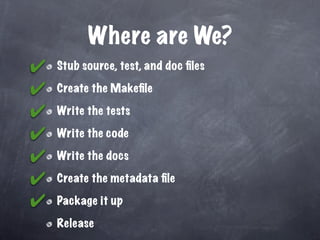
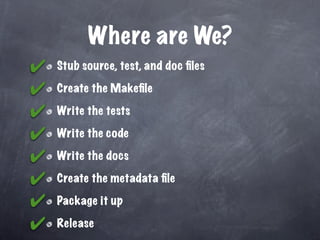
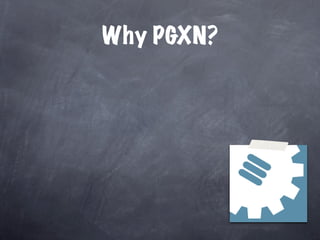
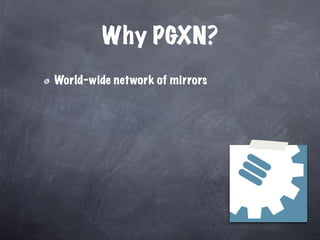

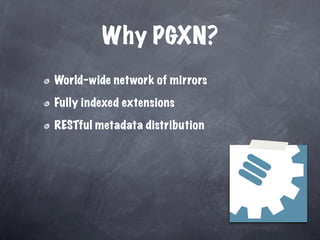
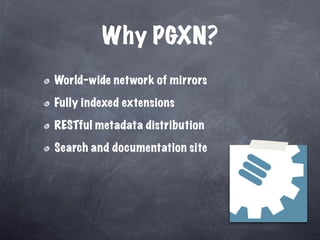

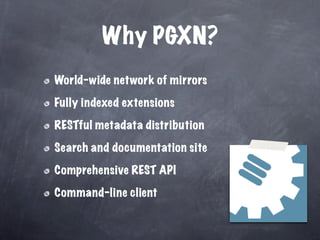

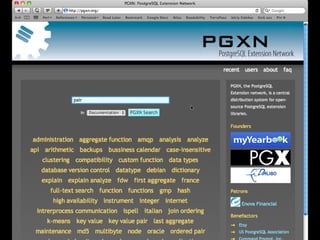
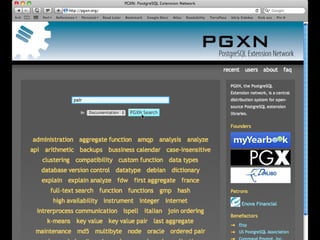


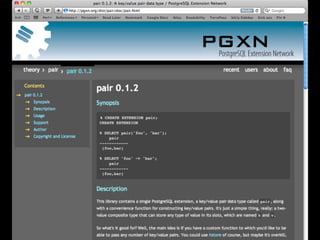
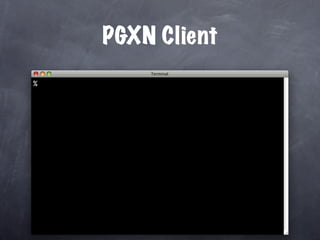

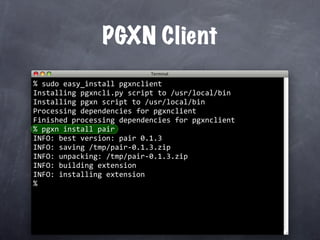
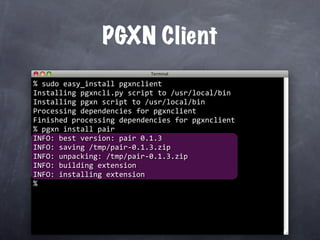






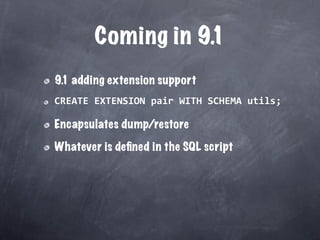
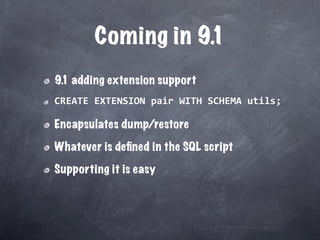








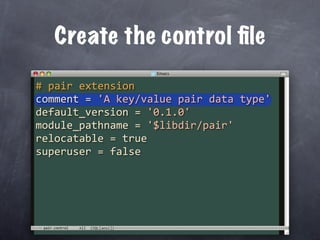


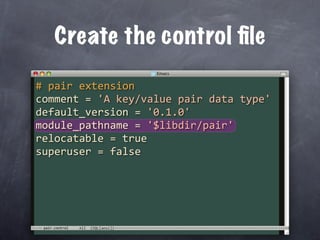
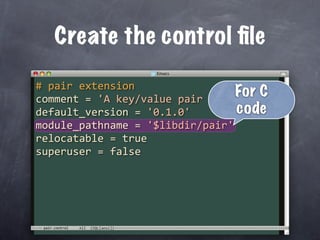
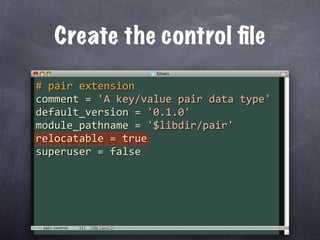
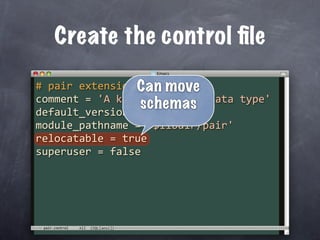

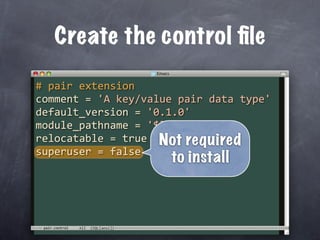

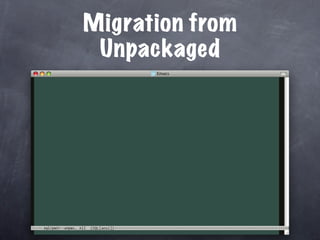


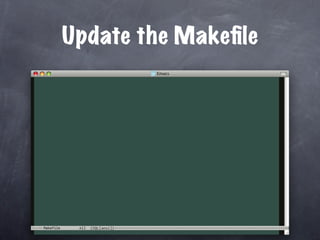
![Update the Makefile
EXTENSION
=
pair
EXTVERSION
=
$(shell
grep
default_version
$(EXTENSION).control
|
sed
‐e
"s/default_version[
]*=[
]*'([^']*)'/1/")
DATA
=
$(filter‐out
$(wildcard
sql/*‐‐*.sql),$
(wildcard
sql/*.sql))
DOCS
=
$(wildcard
doc/*.*)
TESTS
=
$(wildcard
test/sql/*.sql)
REGRESS
=
$(patsubst
test/sql/%.sql,%,$(TESTS))
REGRESS_OPTS
=
‐‐inputdir=test
MODULES
=
$(patsubst
%.c,%,$(wildcard
src/*.c))
PG_CONFIG
=
pg_config
PG91
=
$(shell
$(PG_CONFIG)
‐‐version
|
grep
‐qE
"
8.|
9.0"
&&
echo
no
||
echo
yes)
Makefile](https://image.slidesharecdn.com/extendingpostgresql-110724134253-phpapp02/85/Building-and-Distributing-PostgreSQL-Extensions-Without-Learning-C-252-320.jpg)
![Update the Makefile
EXTENSION
=
pair
EXTVERSION
=
$(shell
grep
default_version
$(EXTENSION).control
|
sed
‐e
"s/default_version[
]*=[
]*'([^']*)'/1/")
DATA
=
$(filter‐out
$(wildcard
sql/*‐‐*.sql),$
(wildcard
sql/*.sql))
DOCS
=
$(wildcard
doc/*.*)
TESTS
=
$(wildcard
test/sql/*.sql)
REGRESS
=
$(patsubst
test/sql/%.sql,%,$(TESTS))
REGRESS_OPTS
=
‐‐inputdir=test
MODULES
=
$(patsubst
%.c,%,$(wildcard
src/*.c))
PG_CONFIG
=
pg_config
PG91
=
$(shell
$(PG_CONFIG)
‐‐version
|
grep
‐qE
"
8.|
9.0"
&&
echo
no
||
echo
yes)
Makefile](https://image.slidesharecdn.com/extendingpostgresql-110724134253-phpapp02/85/Building-and-Distributing-PostgreSQL-Extensions-Without-Learning-C-253-320.jpg)
![Update the Makefile
EXTENSION
=
pair
EXTVERSION
=
$(shell
grep
default_version
$(EXTENSION).control
|
sed
‐e
"s/default_version[
]*=[
]*'([^']*)'/1/")
DATA
=
$(filter‐out
$(wildcard
sql/*‐‐*.sql),$
(wildcard
sql/*.sql))
DOCS
=
$(wildcard
doc/*.*)
TESTS
=
$(wildcard
test/sql/*.sql)
REGRESS
=
$(patsubst
test/sql/%.sql,%,$(TESTS))
REGRESS_OPTS
=
‐‐inputdir=test
MODULES
=
$(patsubst
%.c,%,$(wildcard
src/*.c))
PG_CONFIG
=
pg_config
PG91
=
$(shell
$(PG_CONFIG)
‐‐version
|
grep
‐qE
"
8.|
9.0"
&&
echo
no
||
echo
yes)
Makefile](https://image.slidesharecdn.com/extendingpostgresql-110724134253-phpapp02/85/Building-and-Distributing-PostgreSQL-Extensions-Without-Learning-C-254-320.jpg)
![Update the Makefile
Extract from
EXTENSION
=
pair
EXTVERSION
=
$(shell
grep
default_version
control file
$(EXTENSION).control
|
sed
‐e
"s/default_version[
]*=[
]*'([^']*)'/1/")
DATA
=
$(filter‐out
$(wildcard
sql/*‐‐*.sql),$
(wildcard
sql/*.sql))
DOCS
=
$(wildcard
doc/*.*)
TESTS
=
$(wildcard
test/sql/*.sql)
REGRESS
=
$(patsubst
test/sql/%.sql,%,$(TESTS))
REGRESS_OPTS
=
‐‐inputdir=test
MODULES
=
$(patsubst
%.c,%,$(wildcard
src/*.c))
PG_CONFIG
=
pg_config
PG91
=
$(shell
$(PG_CONFIG)
‐‐version
|
grep
‐qE
"
8.|
9.0"
&&
echo
no
||
echo
yes)
Makefile](https://image.slidesharecdn.com/extendingpostgresql-110724134253-phpapp02/85/Building-and-Distributing-PostgreSQL-Extensions-Without-Learning-C-255-320.jpg)
![Update the Makefile
EXTENSION
=
pair
EXTVERSION
=
$(shell
grep
default_version
$(EXTENSION).control
|
sed
‐e
"s/default_version[
]*=[
]*'([^']*)'/1/")
DATA
=
$(filter‐out
$(wildcard
sql/*‐‐*.sql),$
(wildcard
sql/*.sql))
DOCS
=
$(wildcard
doc/*.*)
TESTS
=
$(wildcard
test/sql/*.sql)
REGRESS
=
$(patsubst
test/sql/%.sql,%,$(TESTS))
REGRESS_OPTS
=
‐‐inputdir=test
MODULES
=
$(patsubst
%.c,%,$(wildcard
src/*.c))
PG_CONFIG
=
pg_config
PG91
=
$(shell
$(PG_CONFIG)
‐‐version
|
grep
‐qE
"
8.|
9.0"
&&
echo
no
||
echo
yes)
Makefile](https://image.slidesharecdn.com/extendingpostgresql-110724134253-phpapp02/85/Building-and-Distributing-PostgreSQL-Extensions-Without-Learning-C-256-320.jpg)
![Update the Makefile
EXTENSION
=
pair
EXTVERSION
=
$(shell
grep
default_version
$(EXTENSION).control
|
sed
‐e
"s/default_version[
]*=[
]*'([^']*)'/1/")
DATA
=
$(filter‐out
$(wildcard
sql/*‐‐*.sql),$
(wildcard
sql/*.sql))
DOCS
=
$(wildcard
doc/*.*)
TESTS
=
$(wildcard
test/sql/*.sql)
REGRESS
=
$(patsubst
test/sql/%.sql,%,$(TESTS))
REGRESS_OPTS
=
‐‐inputdir=test
MODULES
=
$(patsubst
%.c,%,$(wildcard
src/*.c))
PG_CONFIG
=
pg_config
PG91
=
$(shell
$(PG_CONFIG)
‐‐version
|
grep
‐qE
"
8.|
9.0"
&&
echo
no
||
echo
yes)
Makefile](https://image.slidesharecdn.com/extendingpostgresql-110724134253-phpapp02/85/Building-and-Distributing-PostgreSQL-Extensions-Without-Learning-C-257-320.jpg)
